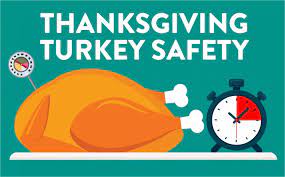Tuesday "Turkey" Tips Food Safety Tips for Your Holiday Turkey


Handling poultry (chickens and turkey) incorrectly and undercooking it are the most common problems that lead to foodborne disease outbreaks linked to poultry. Follow these five tips to help you safely prepare your next holiday turkey meal.

1. Thaw Your Turkey Safely
• In the refrigerator in a container;
• In a leak-proof plastic bag in a sink of cold water (change the water every 30 minutes); or
• In the microwave, following the microwave oven manufacturer’s instructions.
Never thaw your turkey by leaving it out on the counter. A thawing turkey must defrost at a safe temperature. When the turkey is left out at room temperature for more than 2 hours, its temperature becomes unsafe. Bacteria can grow rapidly in the “danger zone” between 40°F and 140°F.
Do not wash or rinse raw turkey
Federal food safety advice has recommended against washing turkey or chicken since 2005, but some habits are hard to break. A 2020 survey* found that 78% of participants reported washing or rinsing turkey before cooking. Old recipes and family cooking traditions may keep this practice going, but it can make you and your family sick. Poultry juices can spread in the kitchen and contaminate other foods, utensils, and countertops.
2. Handle Your Turkey the Right Way
Raw poultry can contaminate anything it touches with harmful bacteria. Follow the four steps to food safety—clean, separate, cook, and chill—to prevent the spread of bacteria to your food, family, and friends.
• Wash hands with warm soapy water for 20 seconds before and after handling turkey.
• Use a separate cutting board for raw turkey.
• Never place cooked food or fresh produce on a plate, cutting board, or other surface that previously held raw turkey.
• Wash cutting boards, utensils, dishes, and countertops with hot soapy water after preparing turkey and before you prepare the next item.
3. Cook Stuffing Thoroughly
Cooking stuffing separately from the turkey in a casserole dish makes it easy to be sure it is thoroughly cooked. If you cook stuffing in the turkey, put the stuffing in the turkey just before cooking.
With either cooking method, use a food thermometer to make sure the stuffing’s center reaches 165°F. Bacteria can survive in stuffing that has not reached 165°F and may then cause food poisoning. If you cook stuffing in the turkey, wait 20 minutes after taking the bird out of the oven before removing the stuffing; this allows it to cook a little more. Learn more about how to prepare stuffing safely.
Use a food thermometer to check for a safe internal temperature.
4. Cook Your Turkey Thoroughly
Set the oven temperature to at least 325°F. Place the completely thawed turkey in a roasting pan that is 2 to 2-1/2 inches deep. Cooking will vary depending on the weight of the turkey. Use a food thermometer to make sure the turkey has reached a safe internal temperature of 165°F. Check by inserting a food thermometer into the center of the stuffing and the thickest portions of the breast, thigh, and wing joint. Even if your turkey has a pop-up temperature indicator, you should still use a food thermometer to check that it is safely cooked.
Let the turkey stand 20 minutes before removing all stuffing from the cavity and carving the meat. Learn more about safe minimum cooking temperature and how to use a food thermometer for turkey and other foods.
5. Take Care of Leftovers
The bacteria Clostridium perfringens grows in cooked foods left at room temperature. It is the second most common bacterial cause of food poisoning. The major symptoms are vomiting and abdominal cramps within 6 to 24 hours after eating.
• Clostridium perfringens outbreaks occur most often in November and December.2
• Many of these outbreaks have been linked to foods commonly served during the holidays, such as turkey and roast beef.
Refrigerate leftovers at 40°F or colder as soon as possible and within 2 hours of preparation to prevent food poisoning. Slice or divide big cuts of meat, such as a roast turkey, into small quantities for refrigeration so they can cool quickly. Reheat all leftovers to at least 165°F before serving.
#naturalhomebrands #turkey #thanksgiving #turkeysafetytips #Tuesdaytips
- Carole Zellers